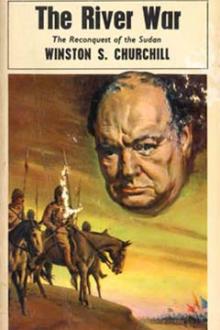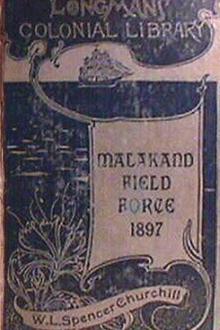The River War by Winston Churchill (spiritual books to read txt) 📕

- Author: Winston Churchill
- Performer: -
Book online «The River War by Winston Churchill (spiritual books to read txt) 📕». Author Winston Churchill
‘Another disaster in the Soudan’—such were the whispers. A check would be the signal for an outcry. The accounts of ‘The Death March’ had not yet reached England; but the correspondents, irritated at being ‘chained to headquarters,’ were going to see about that. And, besides all this, there were the army to feed and the Dervishes to fight. In this serious emergency, which threatened to wreck his schemes, the Sirdar’s organising talents shone more brilliantly than at any other moment in this account.
Travelling swiftly to Moghrat, he possessed himself of the telephone, which luckily still worked. He knew the exact position or every soldier, coolie, camel, or donkey at his disposal. In a few hours, in spite of his crippled transport, he concentrated 5,000 men on the damaged sections of the line, and thereafter fed them until the work was finished. In seven days traffic was resumed. The advance had been delayed, but it was not prevented.
On the 5th of September the 1st (Lewis) and 2nd (MacDonald) Brigades moved to Dulgo, and at the same time the remainder of the army began to march across the loop from Kosheh by Sadin Fanti to Absarat.
Every available soldier had been collected for the final operation of the campaign.
The Expeditionary Force was organised as follows: Commander-in-Chief: The SIRDAR
The Infantry Division: COLONEL HUNTER Commanding 1st Brigade 2nd Brigade 3rd Brigade 4th Brigade MAJOR LEWIS MAJOR MACDONALD MAJOR MAXWELL MAJOR DAVID
3rd Egyptians XIth Soudanese 2nd Egyptians 1st Egyptians 4th ” XIIth ” 7th ” 5th “
IXth Soudanese XIIIth ” 8th ” 15th “
Xth “
Cavalry Brigade and Mounted Forces: MAJOR BURN-MURDOCH
Cavalry … . . 8 squadrons Camel Corps … . 6 companies Horse Artillery … 1 battery Artillery: MAJOR PARSONS
Field Artillery … 2 batteries Maxims … . 1 battery (British) Divisional Troops: MAJOR CURRIE
North Staffordshire Regiment … . 1st Battalion The Flotilla: COMMANDER COLVILLE
Gunboats … Zafir, Tamai, Abu Klea, Metemma, El Teb Armed Steamers … Kaibar, Dal, Akasha Total: 15,000 men, 8 war-vessels, and 36 guns Thus thirteen of the sixteen battalions of the Egyptian Army were employed at the front. Two others, the 6th and XIVth, were disposed along the line of communication, holding the various fortified posts. The 16th Battalion of reservists remained at Suakin. The whole native army was engaged in the war, and the preservation of domestic order in the capital and throughout the Khedive’s dominions was left entirely to the police and to the British Army of Occupation. By the 9th all four brigades had reached the rendezvous at Dulgo; on the 10th the British regiment, which it was determined to send up in the steamers, was moved to Kosheh by rail from Sarras and Gemai. The Sirdar prepared to start with the flotilla on the 12th.
But a culminating disappointment remained. By tremendous exertions the Zafir had been finished in time to take part in the operations.
Throughout the army it was expected that the Zafir would be the feature of the campaign. At length the work was finished, and the Zafir floated, powerful and majestic, on the waters of the Nile. On the afternoon of the 11th of September many officers and men came to witness her trial trip.
The bank was lined with spectators. Colville took command. The Sirdar and his Staff embarked. Flags were hoisted and amid general cheering the moorings were cast off. But the stern paddle had hardly revolved twice when there was a loud report, like that of a heavy gun, clouds of steam rushed up from the boilers, and the engines stopped. Sir H. Kitchener and Commander Colville were on the upper deck. The latter rushed below to learn what had happened, and found that she had burst her low-pressure cylinder, a misfortune impossible to repair until a new one could be obtained from Halfa and fitted.
In spite of this, however, the advance was not delayed. On the 13th the 1st, 2nd, and 3rd Brigades occupied Kaderma. Here the flotilla overtook them, and henceforward the boats on the river kept pace with the army on the bank. Fareig was reached on the 14th, and as the numerous palms by the water afforded a pleasant shade a halt of two days was ordered. On the 16th the 4th Brigade arrived, and the concentration of the force was then complete.
After the annihilation of his strong advanced post at Firket, the Dervish Emir, Wad Bishara, concentrated his remaining forces in Dongola. Here during the summer he had awaited, and in the middle of August some small reinforcements under one Emir of low rank reached him from Omdurman. The Khalifa, indeed, promised that many more should follow, but his promises long remained unfulfilled, and the greatest strength that Bishara could muster was 900 Jehadia, 800 Baggara Arabs, 2,800 spearmen, 450 camelmen, 650 cavalry—in all 5,600 men, with six small brass cannon and one mitrailleuse gun. To augment in numbers, if not in strength, this small force of regular soldiers, he impressed a large number of the local tribesmen; but as these were, for the most part, anxious to join the Government troops at the first opportunity, their effect in the conflict was inconsiderable.
The first sign that the forces were drawing closer was the cutting of the telegraph-wire by a Dervish patrol on the 6th of September. On the 10th the Sirdar heard that Kerma was strongly held. On the 15th of September the Egyptian cavalry first established contact with the Dervish scouts, and a slight skirmish took place. On the 18th the whole force advanced to Sardek, and as Bishara still held his position at Kerma it looked as if an action was imminent. It was resolved to attack the Dervish position at Kerma at dawn. Although it seemed that only four miles separated the combatants, the night passed quietly. With the first light the army began to move, and when the sun rose the spectacle of the moving masses of men and artillery, with the gunboats on the right, was inspiring. The soldiers braced themselves for the expected action. But no sooner were the village and fort of Kerma visible than the report passed along the ranks that they were deserted. Rumour was soon merged in certainty, for on reaching Kerma it was found that the Dervishes had evacuated the place, and only the strong, well-built mud fort attested the recent presence of Bishara.
Whither had he gone? The question was not left unanswered.
Half a mile to the southward, on the opposite bank of the river, among the groves of palm-trees ran a long and continuous line of shelter trenches and loopholed walls. The flanks of this new position rested on the deep morasses which extend from the river both on the north and south sides of Hafir. A small steamer, a fleet of large gyassas and other sailing vessels moored to the further shore explained what had happened. Conscious of his weakness, the prudent Emir had adroitly transported himself across the river, and had thus placed that broad flood between his troops and their destruction.
Meanwhile the three gunboats—all that now remained of the armed flotilla, for the Teb had run on a rock in the Hannek Cataract—were steaming gradually nearer the enemy, and the army swung to the right, and, forming along the river bank, became spectators of a scene of fascinating interest.
At half-past six the Horse battery unlimbered at the water’s edge, and began to fire obliquely up and across the river. As soon as the first few shells had reached the Arab entrenchment the whole line of shelter trenches was edged with smoke, and the Dervishes replied with a heavy rifle fire. The distance was, however, too great for their bad rifles and inferior ammunition, and their bullets, although they occasionally struck the ground on which the infantry were drawn up, did not during the day cause any loss to the watching army.
The Dervish position was about half a mile in length. As the gunboats approached the northern end they opened fire with their guns, striking the mud entrenchments at every shot, and driving clouds of dust and splinters into the air. The Maxim guns began to search the parapets, and two companies of the Staffordshire Regiment on board the unarmoured steamers Dal and Akasha fired long-range volleys. Now, as on other occasions throughout the war, the Dervishes by their military behaviour excited the admiration of their enemies. Encouraged by the arrival in the morning of a reinforcement from Omdurman of 1,000 Black Jehadia and 500 spearmen under Abdel Baki, the Dervish gunners stood to their guns and the riflemen to their trenches, and, although suffering severely, maintained a formidable fire.
The gunboats continued to advance, beating up slowly against the strong current. As they came opposite Hafir, where the channel narrows to about 600 yards, they were received by a very heavy fire from guns placed in cleverly screened batteries, and from the riflemen sheltered in deep pits by the water’s edge or concealed amid the foliage of the tops of the palm-trees. These aerial skirmishers commanded the decks of the vessels, and the shields of the guns were thus rendered of little protection.
All the water round the gunboats was torn into foam by the projectiles.
The bullets pattered against their sides, and, except where they were protected by steel plates, penetrated. One shell struck the Abu Klea on the water-line, and entered the magazine. Luckily it did not explode, the Dervishes having forgotten to set the fuse. Three shells struck the Metemma. On board the Tamai, which was leading, Commander Colville was severely wounded in the wrist; Armourer-Sergeant Richardson was killed at his Maxim gun, and on each boat some casualties occurred. So hot was the fire that it was thought doubtful whether to proceed with the bombardment, and the Tamai swung round, and hurried down the river with the current and at full steam to report to the Sirdar. The other gunboats remained in action, and continued to shell the Dervish defences. The Tamai soon returned to the fight, and, steaming again up the river, was immediately hotly re-engaged.
The sight which the army witnessed was thrilling.
Beyond the flood waters of the river, backed against a sky of staring blue and in the blazing sunlight, the whole of the enemy’s position was plainly visible. The long row of shelter trenches was outlined by the white smoke of musketry and dotted with the bright-coloured flags waving defiantly in the wind and with the still brighter flashes of the guns. Behind the entrenchments and among the mud houses and enclosures strong bodies of the jibba-clad Arabs were arrayed. Still further back in the plain a large force of cavalry—conspicuous by the gleams of light reflected from their broad-bladed spears—wheeled and manoeuvred. By the Nile all the tops of the palm-trees were crowded with daring riflemen, whose positions were indicated by the smoke-puffs of their rifles, or when some tiny black figure fell, like a shot rook, to the ground. In the foreground the gunboats, panting and puffing up the river, were surrounded on all sides by spouts and spurts of water, thrown up by the shells and bullets.
Again the flotilla drew near the narrow channel; again the watching army held their breath; and again they saw the leading boat, the Metemma, turn and run down stream towards safety, pursued by the wild cheers of the Arabs. It was evident that the gunboats were not strong enough to silence the Dervish fire. The want of the terrible Zafir was acutely felt.
The firing had lasted two hours and





Comments (0)